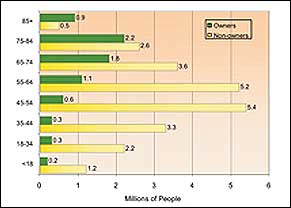Practice Management | February 2014 Hearing Review
Increasing your productivity and that of your staff is a goal that every practice should have. Indeed, “doing more with the same or less” is one of the goals of every well-managed business.
Yet, many practice owners or managers are sidetracked in their quest for greater productivity by having an overwhelming number of things to do. This can cause mental anxiety and stress, two productivity sappers. These sappers prevent them from being clear-headed, staying positive and energetic, and being relaxed and in control—ingredients they need to have for themselves and their staffs to function more productively.
At American Hearing Aid Associates (AHAA), we use five steps when discussing how to increase productivity with our network members. Its initials are CPOAR: collect, process, organize, act, and review. A summary of the steps follows.
1) Collect
The first step is to collect all performance data related to your operations with an open mind. Don’t let preconceived notions skew your perception of reality. One tip: Ideas for improvement that remain “on your mind” can quickly lose clarity. Find a way as you go along to put into writing the main points that you develop.
Identify your collections systems, too, and analyze just how much data you are accumulating on a daily, weekly, and monthly basis. Note that we often collect too many things, which can slow us down with unnecessary information.
Also consider how and how often you are “touching” persons on your staff for input and ideas. How are you collecting behavioral data? What pitfalls of current behaviors are preventing you or your staff from moving to a higher level of performance?
2) Process
The next step is to process what you have found. Too often we chase a goal or collect data without defining why we are doing so. We were born with a natural ability to plan, but society and technology can cloud what nature intended.
Do you plan with an end in mind? Do you incorporate new ideas, or when brainstorming with your staff, is it your idea you implement most of the time? Have you envisioned wild success lately, or do you leave imagined barriers in place? Have you considered all of the new items you can implement to naturally accelerate your practice’s growth?
Have you agreed on the standards or behaviors that you have come to expect with your staff—your team members? Do you know what is critical to accomplish and set timelines for expected actions? Have you planned how to deal with things that may go wrong?
3) Organize
Organizing your office and your plans can be as simple as a bunch of manila folders, a Day Planner, MS Outlook, or Mac applications. Whatever system you choose, keep it as simple as possible. Many different organizational tools exist. Everyone has his or her preference. The key is to get “stuff” out of your head and into a manageable list. By organizing your action items, you eliminate “leakage” and are able to track progress toward completion.
Moreover, through organization, you can simplify your life and eliminate noise, distractions, and the stress and anxiety that are self-imposed from forgetting things that you really needed to do.
All of the items and data you have collected and processed can fit into eight categories:
- Recycle (trash)
- Reuse (someday)
- Reference (when required)
- Projects
- Project plans
- Delegate
- Completion deadlines (specific)
- As soon as possible
So, armed with a recorded list of any item that you don’t need to recycle, you are left with a list of items that need action. You can now put those items into each of the above categories. And the list provides you with an actionable tracking sheet that defines behavioral performance.
4) Act
Looking at our categories above, focus on actionable items, ones that should be converted to projects.
If an item will take 2 minutes or less, do it right away! Procrastination causes anxiety and fills up memory that is needed for more important things. Doing quick tasks, moreover, gives one a sense of accomplishment and empties inboxes.
If an item will take more than 2 minutes, determine if you or someone else is better at getting it done. However, also consider if you are still responsible for the task once you delegate it.
For actionable projects you identify, determine how soon they must be completed according to their priority. As necessary, assign completion deadlines for each, including ones you elect to do.
In assigning projects, tell your staff members what you want them to do. Make sure they understand the task assigned, as well as the deadline established. As necessary, you may have to give them guidance on how to get started.
In dealing with staff, encourage them to remain fresh and focused and to engage their creativity. Start them with priority projects—ones that are most important and that add value to their performance and to the practice as a whole.
Impress upon them the necessity of their planning the steps they need to perform to accomplish assigned tasks, always considering what they will do one day and what they will do the next. In other words, they need to preplan how they will approach the task and how they will see it to completion.
This is important: We find that the more you motivate and encourage your staff members to stretch beyond their own perceived limitations, the more likely they are to succeed and the more confidence they will accrue in their own abilities. This is a key ingredient to increasing productivity in your practice.
5) Review
How often do (we!) put things down and then forget where we put the reminder or, worse, not look at the reminder at all? Let’s try to avoid that.
The items that wind up in your projects, project plans, delegate, completion, and ASAP categories need continual review. My own mantra is What gets managed gets done.
At what levels do you find yourself reviewing your “to dos”? What does your current review process look like? We can look at six levels to review your work and that of your staff:
- Current actions;
- Current projects;
- General areas of responsibility;
- 1 to 2 year goals;
- 3 to 5 year visions; and
- Lifetime.
Reviews of shorter-range goals and projects should be at least weekly. Obtain progress reports for items delegated to staff, update your progress lists, and you will have a clean, clear, and current picture of where progress on objectives stands. Record all of the input to get it off your “mind” and into a place that you can refer to the next week.
Conclusion
Mental anxiety results usually not from too many commitments but rather from too many broken or unfulfilled ones. Stress levels rise when we do not have a way to handle the “fire hose.”
A natural planning and delegation process will open up your and your staff’s minds’ capabilities to drive productivity and success.
It is critical that you develop and manage an effective way to collect, process, organize, act on, and review items that will contribute to increased productivity and revenue. Doing so will allow you to move your practice forward effectively and give you and your staff a sense of tangible accomplishment.
Acknowledgement
Many years ago, I enjoyed reading David Allen’s Getting Things Done. I have leaned on some of his advice for improving one’s personal productivity for our approach to helping AHAA’s network members improve the productivity of their practices. More information about the AHAA network can be obtained at: www.ahaanet.com
More on practice management from Tina Soika can be accessed by clicking here in the Hearing Review digital edition at: http://hr.alliedmedia360.com
CORRESPONDENCE can be addressed to Tina Soika at: [email protected]
Original citation for this article: Soika, T. Five steps to increased productivity: Increasing productivity is the key to increasing profits. Hearing Review. 2014, February: 26-28.





